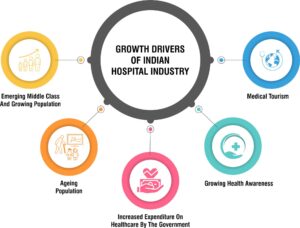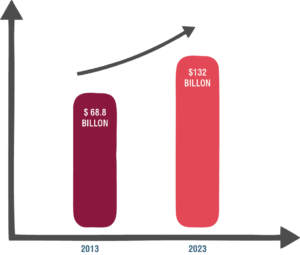The Indian Healthcare Industry, comprising hospitals, telemedicine, medical tourism, medical apparatus, doctors, and medical equipment, is rising at a remarkable pace. The hospital industry of India is emerging at double speed due to progression in technology and growth in multiple diseases.
As per the reports by India Brand Equity Foundation, the Indian Hospital Industry accounting for 80% of the total healthcare is expected to touch the US $132 billion by the year 2023, indicating substantial growth. The growth in the industry is driven by an increase in income of the middle class, health awareness, and penetration of health insurance.
The report by Niti Ayog (National Institution for Transforming India) states that “In the hospital segment, the expansion of private players to Tier 2 and Tier 3 locations, beyond metropolitan cities, offers an attractive investment opportunity.”
GROWTH DRIVERS OF THE HOSPITAL INDUSTRY

-
Emerging Middle Class And Growing Population
The population of India is rising significantly, and an increase in population means that the demand for hospital services will also rise. As the population is demanding high-quality healthcare services, new hospital projects are mushrooming in the country. Furthermore, the increase in per capita expense from this group can lead to the growth of the hospital industry.
-
Growing Health Awareness
People are now getting more health-conscious, they are now more aware of the diseases. The growing education and awareness about the diseases, increase the demand for the hospital and its services. The increase in chronic and infectious diseases also helps in driving the growth of the hospital industry.
-
Ageing Population
With the increase in population, India’s demographic pattern has seen a major transition. The population above the age of 60 is continuing to grow. In 2013, elderly people were only 8% of the total population, but it is estimated that this number can reach 18.3% by 2050. With this pattern, the demand for the hospital industry will increase substantially. Elderly people experience more morbidity patterns. To provide the elderly population with all the medical access and service, the hospital industry is getting a big opportunity for growth.
-
Medical Tourism
Medical Tourism in India is rapidly becoming a million-dollar business and will surely play the role of a key driver in the growth of the hospital industry. India has skilled and multi-speciality hospitals and expert professionals that make India a medical tourism destination. According to Medical Tourism Association, India is ranked 10th out of 46 in 2020-2021. The market is expected to stand at US$13.42 billion by 2026, which was estimated at US$ 2.89 billion in 2020.
-
Increased expenditure on healthcare by the government
The Union Budget 2022-2023 has allocated INR 86,200 crore to the Ministry of Health and Family Welfare, a nearly 16.5 per cent increase in comparison to what was allocated in FY 2020-2021 i.e. 73,932 crores.
GOVERNMENT’S INITIATIVES
The Indian government is taking the necessary steps to strengthen the healthcare system. Some of the initiatives mentioned in the Union Budget of 2022-23 are:
-
Ayushman Bharat
The Ayushman Bharat is a much-appreciated scheme introduced by the Indian government. It covers the medical benefit of Rs. 5 lakh per family per year. The scheme helps the vulnerable group of society to reduce the burden of medical expenses.
-
Pradhan Mantri Swasthya Suraksha Yojana
The Scheme was initiated in 2006, in order to make healthcare facilities affordable for every part of society. This scheme also facilitates medical education across India, especially in those areas that are under-developed. Indian government allocated Rs. 10,000 Crore to ‘Pradhan Mantri Swasthya Suraksha Yojana’ in Union Budget 2022-23.
-
Pradhan Mantri Garib Kalyan Package
It was launched in October 2021 to provide insurance to healthcare workers fighting Covid 19. It was allocated INR 226 crore in Union Budget 2022-23, as compared to INR 813 crore in budget 2021-2022, indicating a decrease of 72 per cent.
Along with these key schemes, there are some other initiatives as well, taken by the Indian government to make healthcare facilities affordable and of quality. ‘National Health Mission’ and ‘National Ayush Mission’ are among much-appreciated schemes initiated by the government.
PEOPLE’S PREFERENCE FOR PRIVATE HOSPITALS
Good health of the population is the ‘Wealth of the Nation’. After Indian attained independence, only 15% of people were using private hospitals. But in the contemporary era, the tables have completely turned. The patient preference towards the kind of hospital depends on the quality standards of the service providers, self affordability, and accessibility. While private hospitals provide a high standard of treatment and hygiene conditions, public hospitals fail to provide such facilities. Private hospitals concentrate on delivering secondary and tertiary health service, while public hospitals only focus on basic primary healthcare.
Taking hospitalization and non-hospitalization cases together, almost two-thirds of the Indian population gets treatment from private hospitals rather than public hospitals.

FINAL THOUGHT
The scope of the hospital industry in India is vast and full of opportunities. India offers tremendous scope in R&D as well as medical tourism. The Indian healthcare sector is indeed delivering the best medical services to the people and is eventually getting better.



